News and Events
Surveillance of Point-of Purchase Tobacco Advertising and Placement in Local Businesses
Gilchrist County, Florida
by Barry Hummel, Jr., MD, Co-Founder, Quit Doc Research and Education Foundation, August 2010
Introduction:
During the fourth quarter of the current fiscal year, surveillance was conducted to evaluate point-of-purchase tobacco advertising and product placement in Gilchrist County, Florida. Our core concern is the level of tobacco advertising and the amount of self-service tobacco to which youth are exposed in the local community.
We were particularly concerned about the amount of tobacco advertising seen by Gilchrist County middle and high school students. As a result, we focused our survey to potential tobacco retailers within a 3-mile radius of both the Trenton Middle/High School campus, and the Bell Middle/High School campus. Because of the proximity of the Trenton Elementary and the Bell Elementary campuses, data from this county reflects the exposure of these younger populations to tobacco advertising as well.
To conduct the survey, QDREF utilized the StoreALERT report card; this method was developed as part of a national study, and is currently monitored by the Campaign for Tobacco-Free Kids. The StoreALERT survey looks at both exterior and interior advertising (see attached). The StoreALERT program also provides training materials to allow participation by volunteers.
QDREF also conducted training sessions to recruit volunteers from the Gilchrist County SWAT youth to participate in the study.
Using the Google search engine, QDREF staff compiled a list of potential businesses from each of the following categories:
- Stand-Alone Convenience Stores
- Stand-Alone Gas Stations
- Gas & Convenience Stores
- Grocery Stores
- Supermarkets
- Drug Stores
- Pharmacies
- Liquor Stores
- Tobacco Store
These businesses were chosen based on the criteria of the StoreALERT Survey. 14 individual businesses in Bell and Trenton were identified using this method.
Results.
SWAT Youth and QDREF staff visited all 14 stores identified to be within 3 miles of one of the middle and high schools listed.
Overall, among all stores surveyed within 3 miles of middle and high schools, 57.2% received a grade of “D” or “F”, meaning these retail stores had a significant amount of tobacco advertising.
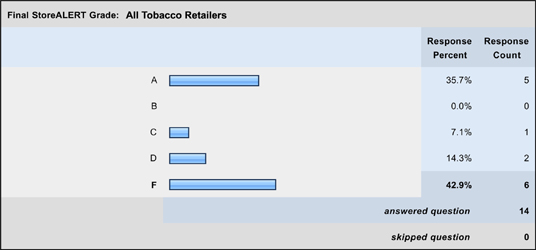
Convenience stores, gas stations, and combined stores were the worst offenders. Because of the small number of stores, we studied the statistics of these three types of stores as a group. 100% of these types of stores received a grade of “D” or “F”!
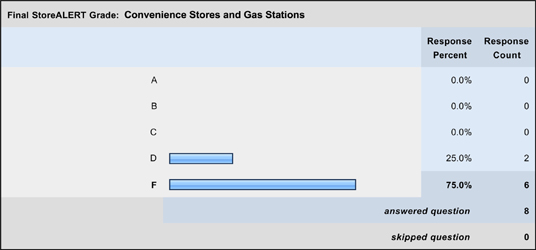
For comparison, we lumped together all of the remaining tobacco retailers in the survey (grocery stores, supermarkets, pharmacies, liquor stores, general stores, etc.). 83.3% of these stores received a grade of “A”.
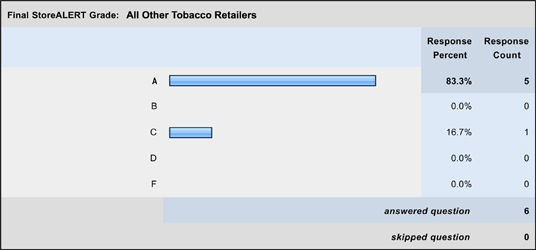
This highlights the issue of tobacco advertising. It is primarily an issue in convenience stores. These are the very stores in which teenagers tend to shop.
Next we looked at two key indicators. The first is tobacco advertsing located outside of the retail outlet. This is important because it affects the entire community, not just the individuals shopping in the stores. Here is a summary outdoor tobacco advertising among all tobacco retailers in Gilchrist County. 57.1% of all tobacco retailers had some level of outdoor tobacco advertising, and 21.4% of those retailers had an overwhelming level of tobacco advertising.
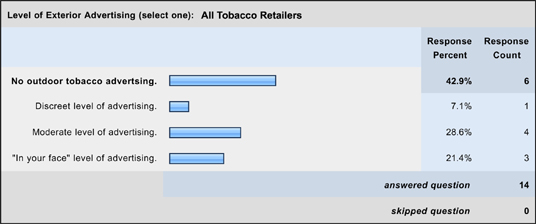
Again, to highlight the difference among the types of stores, we broke the results down into two categories: Convenience stores and gas stations vs. all other tobacco retailers.
Here are the results looking at outdoor tobacco advertising among conveneince stores and gas stations. Only 12.5% of convenience stores chose not to place outdoor tobacco advertising on their property.
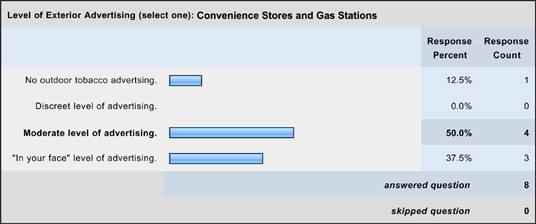
Again, for comparison, here is the summary of outdoor advertising among all other tobacco retailers. Here, an overwhelming 83.3% of retailers chose not to place outdoor tobacco advertisements on their property :
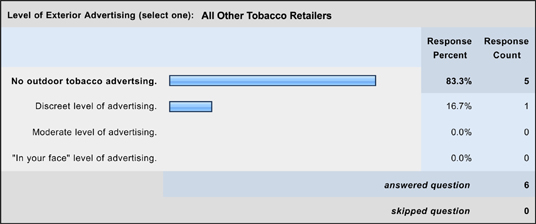
Finally, we focused on self-service tobacco as a key indicator of youth tobacco access. Self service tobacco makes it easier for youth to make tobacco purchases, or to simply steal tobacco in order to start and maintain tobacco addiction.
Below is a summary of self-service tobacco among all tobacco retailers in Gilchrist County. Only 21.4% of tobacco retailers in Gilchrist County currently offer self-service tobacco.

Again, we decided to compare convenience stores and gas stations against all other tobacco retailers. Below is a summary of those convenience stores and gas stations that sell self-service tobacco. The good news is that only 25% of convenience stores offer self-service tobacco.

This is statistically similar to other tobacco retailers in Gilchrist County. Only one non-convenience store retailer offers self-service tobacco in Gilchrist County. Sadly, this is a supermarket in Trenton, which is highly unusual among supermarkets.

Summary:
Surveillance to evaluate the extent of point-of-purchase advertising and tobacco placement in local tobacco retailers was conducted in Gilchrist County during the fourth quarter of fiscal 2010. The study focused on potential tobacco retailers within 3 miles of public school campuses.
The results showed that 57.2% of all stores surveyed within a 3 mile radius of public middle and high schools had a significant amount of tobacco advertising. Convenience stores, gas stations, and combined gas/convenience stores were the worst offenders, with 100% of those combined stores displaying a significant amount of tobacco advertising.
Given the influence of advertising, including tobacco advertising, on children and teens, this data shows a clear need to pursue local ordinances or zoning restriction to limit the scope of tobacco advertising in Gilchrist County retailers. Another approach might be to limit the number, density, or location of these tobacco retailers.
A second area of the surveillance focused on tobacco placement. Only three out of 14 retailers offered self-service tobacco. Given the small number of retailers, the Tobacco Free Partnership should work on educating these retailers on the importance of self-service tobacco and work with the retailers to voluntarily place all tobacco products behind the counter. If this measured approach does not work, it would be in the best interest of the Partnership to pursue an ordinance mandating retailer-assisted tobacco sales within Gilchrist County.


